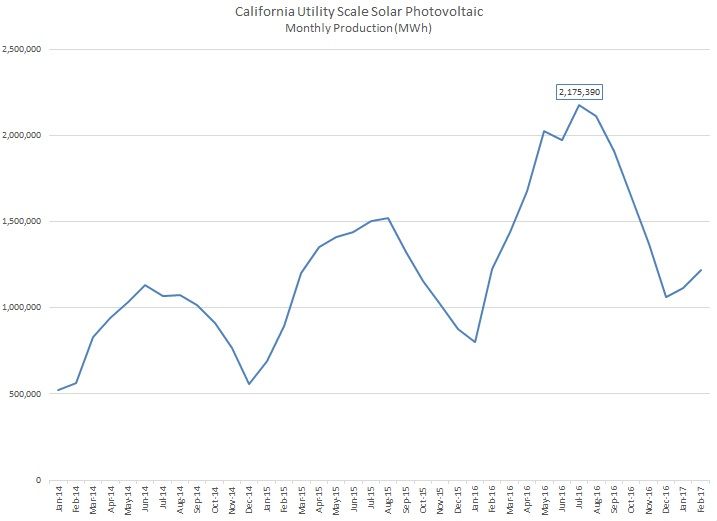Was there some weather in California yesterday and today I did not know about? That could explain this, but I'm somewhat suspicious nevertheless.
I'm showing that while Monday had low sun at my home, Tuesday-Thursday had heavy sun, and I made quite a bit of electricity. I usually experience commonalities between what my system makes and what the utility level solar farms make.
California's solar farms are partially tracked by CAISO.
California ISO - Todays Outlook shows curtailment link. The graphs show today (and now that I look at them, yesterday) had sharp drops in solar and wind during pretty high wind periods that suggest not all of the sun and wind energy was used, and that there may have been heavy curtailment. It is supposed to be updated every day, but Tuesday and Wednesday are mysteriously missing. I suspect that they might be trying to fudge the numbers to cover up how much curtailment has been going on this week.
Curtailment, according to mblake's last linked article, can be strategically used as reserves in small amounts, but bigger amounts of curtailment are more about giving more citizen money to fossil fuel companies, or in some instances, bad planning in grid expansions, but as grid expansions are continuing to fix those errors, that becomes less and less likely. I suspect a combination of all of those things. But if it's a cover up, then I suspect more of the corrupt versions than the non-corrupt versions.
I was right (from the signatures in the graphs): On March 23, 2017, there was
~1.4% of our energy that could have been supplied by wind & solar that instead was supplied by fossil fuels & imports (mixed). The numbers look really big when I compare them to my personal use (what was curtailed from solar and wind in one day for CAISO is enough to power my car for 5 million miles uphill on a cold night with a heavy headwind and heavy rain driving fast, or a Model X pulling a trailer with almost all those problems,
or I could pay for one quarter ($217K) the price of an average home where I live if I sold it all at $0.05/kWh ($434K) and paid 50% taxes), but when it's billed as "only 1.4%", it
seems less. Specifically, there was ~
8.6GWh of
economic solar and wind curtailment in California, on a day when at least 150GWh if not 300GWh (I don't see the imports breakdown) was dirty fuel. So, whatever contracts CAISO, California, PG&E, and the other utility concerns have with various providers, they are intentionally polluting and not paying bills for wind and solar in order to make certain that the bills are paid to polluters instead.
The breakdowns show the following economic curtailments on March 23, 2017 for CAISO:
- Solar 7,414 MWh (7.4GWh)
- Wind 1,275 MWh (~1.3GWh)
That adds up to 8,689MWh (~8.6GWh) curtailment of utility solar and wind, or 5.8% of available utility solar & wind energy for the day curtailed.
That day, of energy managed by CAISO, 25% was supplied by utility supply solar & wind, but without the curtailment, 26.5% could have been supplied by solar & wind.
While the reports say it wasn't for reserves, it might have been for reserves
and economic at the same time, and that might have been hidden, or there may be a technicality that I do not know about.
I also do not know what type of work is going on medium and long term.
At least I can say that it was only 5.8% waste, rather than some greater number. Perhaps that's a success story. I don't know.
Disclaimer: This is only the curtailment that CAISO knows about. They may have a good view into this.
Anyway, things
are getting better generally. Let's just make sure they keep getting better. We have a long way to go.
http://content.caiso.com/green/renewrpt/20170323_DailyRenewablesWatch.pdf
http://content.caiso.com/green/renewrpt/20170323_DailyRenewablesWatch.txt
http://www.caiso.com/Documents/Wind_SolarReal-TimeDispatchCurtailmentReportMar23_2017.pdf
It bears repeating that I'm only talking about that visible at CAISO, and doesn't include smaller installations on the customer side of the meter, which are estimated to be something like 40%-50% of the utility amount, but no one publicly knows.
This last week has had a half-steady amount of curtailment of this type in about the same amounts for a while now, so this seems like something that can get worked on:



